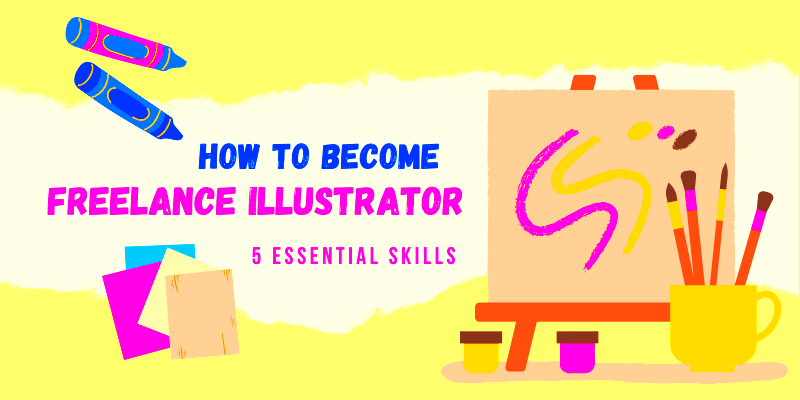Freelance illustrators create unique artwork for clients across a wide range of industries, from publishing and advertising to video games and educational materials. Unlike traditional illustrators tied to a company, freelance illustrators work independently, often handling multiple projects for diverse clients. This flexibility allows them to explore various styles and subjects, making the work both rewarding and varied.
The role of a freelance illustrator isn’t just about creating beautiful images; it also involves understanding client needs, managing deadlines, and adapting to different styles based on project requirements. Freelance illustrators may also need to handle their own marketing, client communication, and finances.
In short, successful freelance illustrators blend creativity with business skills to provide clients with artwork that not only looks good but also meets specific project goals.
Building Essential Illustration Skills

To thrive as a freelance illustrator, you need to develop a strong foundation in essential illustration skills. These core skills will help you tackle diverse projects and maintain high-quality work across different client requirements. Here’s a breakdown of the fundamental skills you should focus on:
- Drawing and Sketching: The backbone of illustration, sketching skills allow you to create detailed, expressive designs that capture client ideas effectively.
- Color Theory: Understanding colors and their emotional impact helps you create engaging and visually cohesive illustrations.
- Composition and Layout: Effective compositions draw viewers’ attention and make artwork more appealing and professional.
- Digital Illustration Software: Proficiency in tools like Adobe Illustrator, Photoshop, or Procreate is essential for digital work.
- Adaptability in Styles: Flexibility with different art styles allows you to meet varied client preferences, from minimalistic to highly detailed art.
Developing these skills will make you versatile and better equipped to handle a variety of freelance projects.
Also Read This: Should I Give Outlook Access to a Fiverr Contractor?
Creating an Impressive Portfolio

Your portfolio is your greatest asset as a freelance illustrator, showcasing your style, skills, and versatility to potential clients. A well-crafted portfolio can set you apart in a competitive field. Here’s how to make your portfolio stand out:
- Select Your Best Work: Include only your best and most representative pieces, highlighting both quality and diversity in style.
- Organize by Project Type: If you specialize in certain types of illustrations (e.g., children’s books, concept art), organize your portfolio by category to help clients find relevant samples.
- Include a Brief Description for Each Piece: Explain the goal of the illustration and any challenges you overcame. This shows clients your problem-solving skills and creative process.
- Use a Professional Online Platform: Hosting your portfolio on platforms like Behance or your own website makes it easily accessible and sharable.
Additionally, make sure your portfolio reflects your current skill level and areas of interest. Regularly updating it with new work will demonstrate growth and keep it relevant.
Also Read This: How Long Does Fiverr Take to Respond to a Dispute Before Itâs Canceled?
Choosing the Right Tools and Software
Choosing the right tools and software is essential for any freelance illustrator, as these are the foundations of your creative process. The tools you choose will depend on whether you work traditionally, digitally, or a mix of both. Here’s a guide to help you get started:
- Hardware: If you’re working digitally, a quality tablet is key. Popular options include the iPad Pro with Apple Pencil or a Wacom tablet, both of which provide precision and comfort for long hours of drawing.
- Software for Digital Illustration: Adobe Illustrator and Photoshop are industry standards for vector and raster graphics, respectively. For a more affordable alternative, Procreate on the iPad is intuitive and powerful. Clip Studio Paint is another popular choice among illustrators for its wide range of brushes and tools.
- Traditional Tools: For those who prefer a hands-on approach, investing in quality pencils, inks, and watercolor or acrylic paints can make a big difference. Paper quality is also crucial; look for acid-free, high-gsm paper for the best results.
- Organizational Tools: Staying organized with project management tools like Trello or Notion helps you keep track of deadlines, client communication, and personal goals.
With the right tools, you’ll find it easier to express your creativity, work efficiently, and produce high-quality illustrations that meet your clients’ expectations.
Also Read This: Why Is Fiverr Homepage Blank When Logged In?
Finding Clients and Job Opportunities
Finding clients as a freelance illustrator can be challenging, especially at first. But with the right approach, you can consistently secure work that matches your skills and interests. Here are some effective ways to find clients:
- Freelance Platforms: Websites like Fiverr, Upwork, and Behance are popular platforms where illustrators can showcase their portfolios and connect with clients. Create a strong profile to attract potential clients on these platforms.
- Social Media: Platforms like Instagram, Twitter, and LinkedIn are great for sharing your work and attracting a following. Use relevant hashtags, engage with other artists, and post regularly to increase visibility.
- Networking with Industry Professionals: Attending art fairs, workshops, or industry events can help you connect with potential clients and other creatives who may refer clients to you.
- Direct Outreach: Don’t hesitate to reach out directly to companies, publishers, or agencies that align with your style. A personalized email with your portfolio link can sometimes open doors to freelance opportunities.
Building a client base takes time, but a steady presence on multiple platforms and consistent effort in networking can increase your visibility and lead to rewarding job opportunities.
Also Read This: Best Fiverr Sellers for Podcast Production in 2024
Setting Your Rates as a Freelance Illustrator
One of the most challenging aspects of freelancing is setting rates that reflect your skill and time while being competitive in the market. Here’s a breakdown of factors to consider when determining your rates:
| Factor | Details |
|---|---|
| Experience Level | If you’re just starting out, your rates may be lower than more experienced illustrators, but they should still reflect the quality of your work. |
| Project Complexity | More detailed or larger illustrations often require higher rates due to the time and skill involved. |
| Client’s Budget | While it’s important to know your worth, understanding a client’s budget can help you negotiate a fair price that works for both of you. |
| Market Rates | Research what other freelance illustrators are charging for similar work to get a sense of market expectations. |
Many illustrators charge by the hour, by project, or based on usage rights (e.g., exclusive versus non-exclusive rights). It can also be helpful to offer tiered pricing packages that give clients options based on complexity and scope. Remember, setting fair and sustainable rates is key to building a successful freelance illustration business.
Also Read This: How to Promote Your Fiverr Gig: Effective Strategies for Success
Marketing Yourself Effectively
Marketing is a critical skill for freelance illustrators, as it helps you connect with clients who are looking for your unique style and talents. Effective self-promotion ensures that potential clients can easily find you, learn about your work, and reach out with project inquiries. Here are some practical ways to market yourself:
- Create a Professional Website: A website serves as your online portfolio and makes it easy for clients to view your work, read about your services, and contact you directly.
- Leverage Social Media: Platforms like Instagram and LinkedIn allow you to share your illustrations, engage with other creatives, and attract a larger audience. Post regularly, use relevant hashtags, and engage with followers to build your online presence.
- Build a Mailing List: Regular newsletters allow you to share updates, showcase new projects, and offer exclusive content to clients and fans. Email marketing is a great way to stay top-of-mind with potential clients.
- Collaborate with Other Creatives: Partnering with writers, designers, or agencies can help you reach a broader audience and gain valuable referrals.
Being active online, consistently sharing your work, and connecting with others in your field will build your brand and attract clients who value your specific skills and style.
Also Read This: How to Sell eBooks on Fiverr: A Step-by-Step Guide
Tips for Success and Growth in Freelance Illustration
Growing as a freelance illustrator involves more than just improving your artistic skills; it’s about managing projects, building client relationships, and continually expanding your knowledge. Here are some tips to help you succeed:
- Keep Learning: Attend workshops, take online courses, and stay updated on new techniques and industry trends to refine your skills and stay competitive.
- Manage Your Time Effectively: Freelancing requires juggling multiple projects, so creating a schedule and setting deadlines for yourself helps you meet client expectations.
- Seek Client Feedback: Constructive feedback is invaluable. It can help you improve your work, understand client needs better, and deliver even higher-quality illustrations in future projects.
- Network with Other Freelancers: Building connections with other illustrators and freelancers can lead to referrals, collaborations, and valuable insights into the industry.
- Stay Consistent: Growth often comes from steady, consistent work. Developing a routine and keeping your portfolio up-to-date shows clients you’re reliable and professional.
These tips can help you not only succeed in the present but also build a lasting and fulfilling freelance career.
Also Read This: How to Withdraw Money from Fiverr in Bangladesh
Frequently Asked Questions
Here are answers to some common questions that new freelance illustrators often have:
- How do I determine my rates as a beginner? It’s common for beginners to charge lower rates while building a portfolio, but be careful not to undervalue your work. Start by researching the average rates in your field, and adjust based on the project’s complexity and your experience.
- Is social media necessary for freelance illustrators? While not required, social media can greatly enhance your visibility and help you connect with clients and other creatives. It’s a valuable marketing tool that lets you showcase your work to a broader audience.
- What’s the best way to find clients outside of platforms like Fiverr? In addition to using freelance platforms, you can find clients by reaching out directly to publishers, agencies, and brands that align with your style. Networking, attending industry events, and maintaining an active online portfolio also help.
- How can I handle challenging clients? Clear communication and setting boundaries are key. Listen to the client’s concerns, offer solutions, and remain professional. If a client continues to be difficult, assess if the project aligns with your business goals.
- What’s the best way to keep improving as an illustrator? Practicing regularly, exploring different styles, and learning from others are great ways to grow. Seeking feedback from clients and other illustrators can also offer insights into areas for improvement.
These FAQs cover some of the main concerns that freelancers face and provide a helpful foundation for navigating a freelance illustration career.
Conclusion
Starting a career as a freelance illustrator offers a unique path to creative freedom and personal fulfillment. While building a sustainable freelance business takes time, effort, and commitment, it’s a rewarding journey for those passionate about art. From developing essential skills and crafting a strong portfolio to marketing yourself effectively and setting fair rates, each step you take builds a solid foundation for success. By continuously refining your craft, connecting with clients, and staying dedicated to growth, you can carve out a lasting and successful career as a freelance illustrator.




